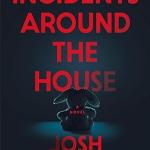 I never did finish reading Anne Rice’s Christ the Lord: Out of Egypt last year, but I probably should get it back from the library and finish it at some point; it was a very intriguing mix of deeply traditional yet spectacularly innovative storytelling. It’s one thing to suggest what Christ might be thinking, as Mel Gibson did in The Passion of the Christ (2004), by using flashbacks and point-of-view shots, but it’s quite another to tell us what Christ is thinking by writing an entire book — nay, an entire trilogy! — in the first person, from Christ’s point of view. Even C.S. Lewis, after writing The Screwtape Letters from a demon’s point of view, said he didn’t dare write a book from the opposite angelic point of view, because “every sentence would have to smell of Heaven.” How much more daunting would a book written from the point of view of God himself be. And yet, Jesus is not merely God; he is a man, too, and the challenge for all Christians is to identify with his humanity and, through it, to identify more fully with that aspect of his divinity that is imprinted on all of us by our Creator yet is currently obscured by our corrupt and sinful nature. Novelists just have to meet this challenge in a different way from the rest of us.
I never did finish reading Anne Rice’s Christ the Lord: Out of Egypt last year, but I probably should get it back from the library and finish it at some point; it was a very intriguing mix of deeply traditional yet spectacularly innovative storytelling. It’s one thing to suggest what Christ might be thinking, as Mel Gibson did in The Passion of the Christ (2004), by using flashbacks and point-of-view shots, but it’s quite another to tell us what Christ is thinking by writing an entire book — nay, an entire trilogy! — in the first person, from Christ’s point of view. Even C.S. Lewis, after writing The Screwtape Letters from a demon’s point of view, said he didn’t dare write a book from the opposite angelic point of view, because “every sentence would have to smell of Heaven.” How much more daunting would a book written from the point of view of God himself be. And yet, Jesus is not merely God; he is a man, too, and the challenge for all Christians is to identify with his humanity and, through it, to identify more fully with that aspect of his divinity that is imprinted on all of us by our Creator yet is currently obscured by our corrupt and sinful nature. Novelists just have to meet this challenge in a different way from the rest of us.
Anyway, one of the reasons why I should probably finish the first book soon is because the second book in Rice’s trilogy, Christ the Lord: The Road to Cana, came out this week — and as one who wrote an entire essay on the treatment of sexuality in Jesus films (for the book Scandalizing Jesus?: Kazantzakis’s The Last Temptation of Christ Fifty Years On), I am very intrigued to read this bit from Cindy Crosby’s review in Books & Culture:
With the plotting of a master storyteller, she weaves together Jesus’ love for a beautiful fifteen-year-old village girl, the gifts of the magi, the wedding at Cana, his baptism, and the opening steps of his ministry. . . .
Rice wants us to understand Jesus in the context of his culture. What would it have meant to be thirty and unmarried in Nazareth? In one early scene, his older brother James demands of Jesus, “What’s the matter with you? … When will you take a wife? … There are two men as old as you in this town who’ve never married. One is crippled. The other’s an idiot.” In one early scene, two boys unjustly accused of homosexual acts are stoned to death. “Be careful men don’t say the same things of you, Yeshua,” his friend Jason tells him, complaining, “Where is your wife, Yeshua, where are your children?”
If I’m not mistaken, Anne Rice’s son is gay, and her vampire books, among others, have had their share of homoerotic content. I have also heard that Rice wrestled with the Church’s teaching on sexuality in particular as she made her way back to Catholicism a few years ago. So it is interesting to see these elements introduced into what is, to all appearances and by all accounts, a deeply, devoutly, and even traditionally constructed life-of-Jesus work.
And it will be very interesting to see how Jesus’ relationship with that 15-year-old girl compares to, say, his chaste interest in Mary the sister of Lazarus in Roger Young’s Jesus (1999; my review).












